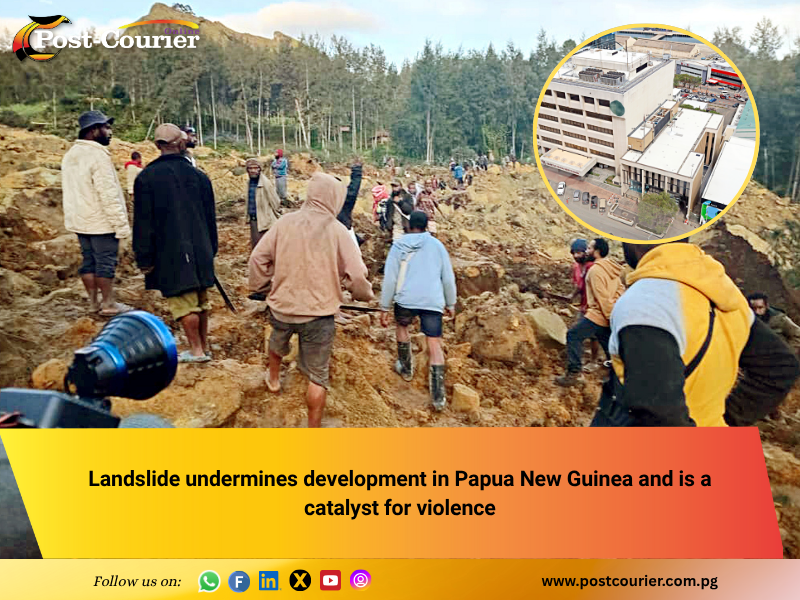Copyright postcourier

Papua New Guinea is prone to natural hazards such as cyclone, earthquake, landslide, flooding, droughts, volcanic eruptions, and rising sea level that leads to displacement of people and economic loss every year. Disasters affect thousands of people on a personal, business, community and national level. Each year the government is forced to spend millions of kinas to rebuild roads, bridges, schools and health centers damaged during disasters. Not only does the government have to deal with this insurmountable task, but it is also faced with limited resources and resurging violence. Landslide experienced in rural parts of the country has claimed the lives of so many innocent people including vulnerable children, the elderly, pregnant women and persons with disabilities. Heavy rain and earthquake are believed to be triggers of why landslide happens. Papua New Guinea continues to experience landslide because of large mountainous areas and high rainfalls. The extent in which damage is sustained range from loss of lives to food gardens, homes, properties destroyed leaving thousands of families displaced and exposed to infectious disease from contaminated water and poor sanitation. Rural communities are more vulnerable with human and animal lives, safety and wellbeing at a greater risk. Despite Papua New Guinea’s long history with natural disasters, the country does not have the resources, infrastructure and technical capacity in place to effectively manage large magnitude of such a crisis. Communities have low awareness and informed knowledge about how to prepare for a disaster. The lack of information among people meant fear, panic, confusion, chaos and often the speed and sudden occurrence of such disaster could leave victims with little to no chance of escape. On January 2, 2024, in a remote place in Wantoat, Morobe, three people died when a movement of soil on a rugged terrain buried them. Along with these fatalities, twenty homes and food gardens were destroyed. One of the victims who died was identified as a young high school student who had a bright future ahead of him. News about his death went viral on Facebook and was picked up by the local journalists and reported in the newspaper and broadcasted via radio. The media had to alert the local and provincial government to respond immediately. After three months on 28 May same year in 2024, a significant landslide occurred in Enga province leading to fatalities and extensive damage impacting communities. The Australian Broadcasting Cooperation reported more than 2,000 people killed, hundreds of homes and properties destroyed and 7,200 displaced. The road connecting the province to the main highway was cut off preventing transportation of equipment and supplies thus hindered the evacuation process. Rescuing people became hard and risky as responders need machines to clear debris while making sure they do not hit those who may be covered underground. The Royal Australian Air Force flew first responders to help in mass evacuation. Lifesaving assistance and support came in from development partners like Australia, United States, New Zealand and humanitarian actors through financial aid, logistics, food, shelter, hygiene kits and water for those affected. News about the magnitude of this landslide made it to CNN and Reuters. Videos posted on social media showing children, women and men openly weeping spoke volume about the grief, trauma and violence experienced. Severity of this environmental crisis in Enga spurred more violence through existing tribal clashes. For example, aid and heavy equipment needed to assist with digging and searching for victims was slow to arrive because of inter-tribal conflicts. The International Organization for Migration (IOM) stated conflict in this region has led to brutal killings and sexual violence as well as extensive damage to schools, healthcare facilities, churches including shelter. It is understood that conflicts arise from land disputes, competition over resources and inter-clan rivalries. The national government in response has deployed police and military personnel to ensure public order and security. As part of the strategy to keep civilians safe and prevent hostilities, soldiers continue to monitor the situation and conduct awareness campaigns with local communities to mitigate tensions and prevent escalation of hostilities. Needs of displaced people would require a close attention with continuous communication and resources to restore and revitalize communities. Each government—local, provincial and national government has its own expertise and resources for response and recovery efforts. As such collaboration between state agencies, humanitarian actors and public-private partnership can increase awareness, develop, tools, practice emergency drills while have in place multi hazard warning system and climate-resilient infrastructures for preparedness. It is also essential to develop communications and build relationships with communities to promote peace and for lasting solutions to conflicts.



